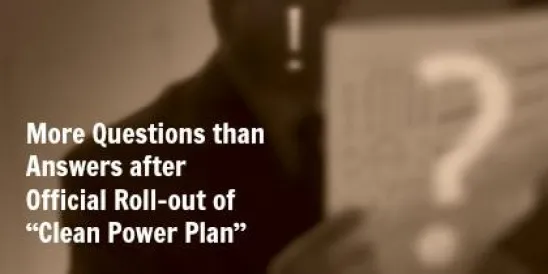As discussed earlier in this blog, on June 2, 2014, the U.S. Environmental Protection Agency released a prepublication copy of its “Clean Power Plan,” or proposed rules regulating greenhouse gas emissions from certain existing electric generating units (EGU), pursuant to Section 111(d) on the Clean Air Act. The proposed rules were met with concern by some stakeholders, welcomed by others and generated apparent confusion among many. The publication of the proposed rules in the Federal Register on June 18, 2014, unfortunately did not do much to resolve many of the outstanding questions related to the long-awaited plan.
BASELINE CLARIFICATION
One of the key issues where considerable confusion remains is the relationship between the baseline year of 2005 for purposes of the 30 percent nationwide emissions reduction target by 2030 and the focus on 2012 as the starting year for individual states’ compliance purposes. This issue was muddled in many early reports discussing the proposed rules, in large part because EPA itself published summaries which only mentioned the 2005 nationwide baseline. In a recent discussion with a representative of EPA Region 8 (covering Colorado, Montana, North Dakota, South Dakota, Utah, and Wyoming), EPA confirmed that this has been one of the more challenging issues to communicate in the rollout of the proposed rules. EPA explained that the 30 percent reduction from 2005 carbon emission levels by 2030 is intended as an “illustrative proposal” of what could be accomplished if all states achieved their respective emission reductions set forth in the Clean Power Plan.
EMISSION RATE VS. QUANTITY OF EMISSIONS
Another issue that has been blurred in early discussions of the proposed rules is the nature of the emission reductions themselves. The Clean Power Plan establishes requirements for reductions in the rate, measured in pounds per megawatt-hour (lb/MW-h), at which EGUs emit carbon dioxide. This is not necessarily the same as reductions in the quantity, measured in pounds, of carbon dioxide emitted. Under some circumstances an individual EGU could reduce its emission rate while still increasing the overall quantity of emissions. For example, an EGU with a high emission rate and low capacity utilization could reduce its emission rate by undertaking efficiency improvements but increase its actual utilization, resulting in greater emissions.
FLEXIBILITY AND BUILDING BLOCKS
EPA explains that this possibility is one example of the flexibility the proposed rules provide the states in developing their own compliance plans. Those compliance plans may, but are not required to, utilize any combination of the four “Building Blocks” identified in the Clean Power Plan – Carbon Dioxide Emission Reductions in Coal Fleet, Redispatch to Existing Natural Gas Combined Cycle (NGCC) Plants, New Renewable Energy or Nuclear Energy Generation and End-Use Energy Efficiency Measures. EPA explained that the “Building Blocks” were combined with reasonable assumptions related to a “Best System of Emission Reductions” to develop each state’s emission reduction goals. EPA assumed that states could achieve emission reductions from the following: a six percent heat rate improvement in the state’s coal fleet, a 70 percent capacity factor ceiling for redispatch to a state’s NGCC fleet, reliance on renewable resources for 13 percent of the state’s energy by 2030 and thereafter and a 10.7 percent cumulative savings from end-use energy efficiency by 2030 and each year thereafter. The Clean Power Plan’s “Goal Computation Technical Support Document” explains this in greater detail, using the state of Ohio as an illustrative example of how the “Building Blocks” and reasonable assumptions were used to generate the reduction goals for that state. Appendix 3 in that document summarizes the proposed interim and final reduction goals for other states.
IMPACTED FACILITIES AND THE EPA INTERACTIVE MAP
EPA has also developed an interactive map showing all of the facilities throughout the United States which are likely impacted by the proposed rule. Colorado, for example, has 20 impacted facilities which can be viewed on the interactive map. The map includes general comments about the likely impacts of climate change in Colorado, efforts already underway to cut greenhouse gas emissions, and then provides detail on the various facilities that will be impacted. The interactive map can be found here.
CONCLUSION
Resolution of these initially confusing issues and further educational efforts will continue to be important now that the formal 120 day comment period has begun. The next step in this process will be public hearings on the proposed rules which are scheduled for July 29-31, 2014, in Atlanta, Denver, Washington, DC, and Pittsburgh. These public meetings should help clarify some of the initial confusion surrounding the proposed rule, and will likely provide opportunities to draft more targeted comments to EPA before the October 16, 2014, comment deadline expires.





 />i
/>i

